MBA 5332: Creativity, Innovation and Design - Team Analysis Report
VerifiedAdded on 2022/09/13
|6
|1414
|19
Report
AI Summary
This report examines the dynamics of a creative team, specifically focusing on a BBC case study. It explores the factors contributing to the team's success, including the importance of shared values, leadership, and a focus on the audience. The report analyzes how the team overcame challenges and fostered innovation. It distinguishes between a group and a team, highlighting the significance of collaboration in a complex environment. The study identifies key factors such as inspiring creativity, respecting individual ideas, and maintaining a healthy working environment. The report also addresses the role of leadership in motivating and enabling team members to contribute to organizational goals. The BBC's approach to overcoming challenges, such as staff fatigue, by embracing diverse ideas and promoting open communication through staff consultation sessions is also discussed. The report emphasizes the importance of creative approaches in influencing people and enhancing their willingness to achieve organizational goals. This document, available on Desklib, provides a comprehensive understanding of team dynamics and innovation.
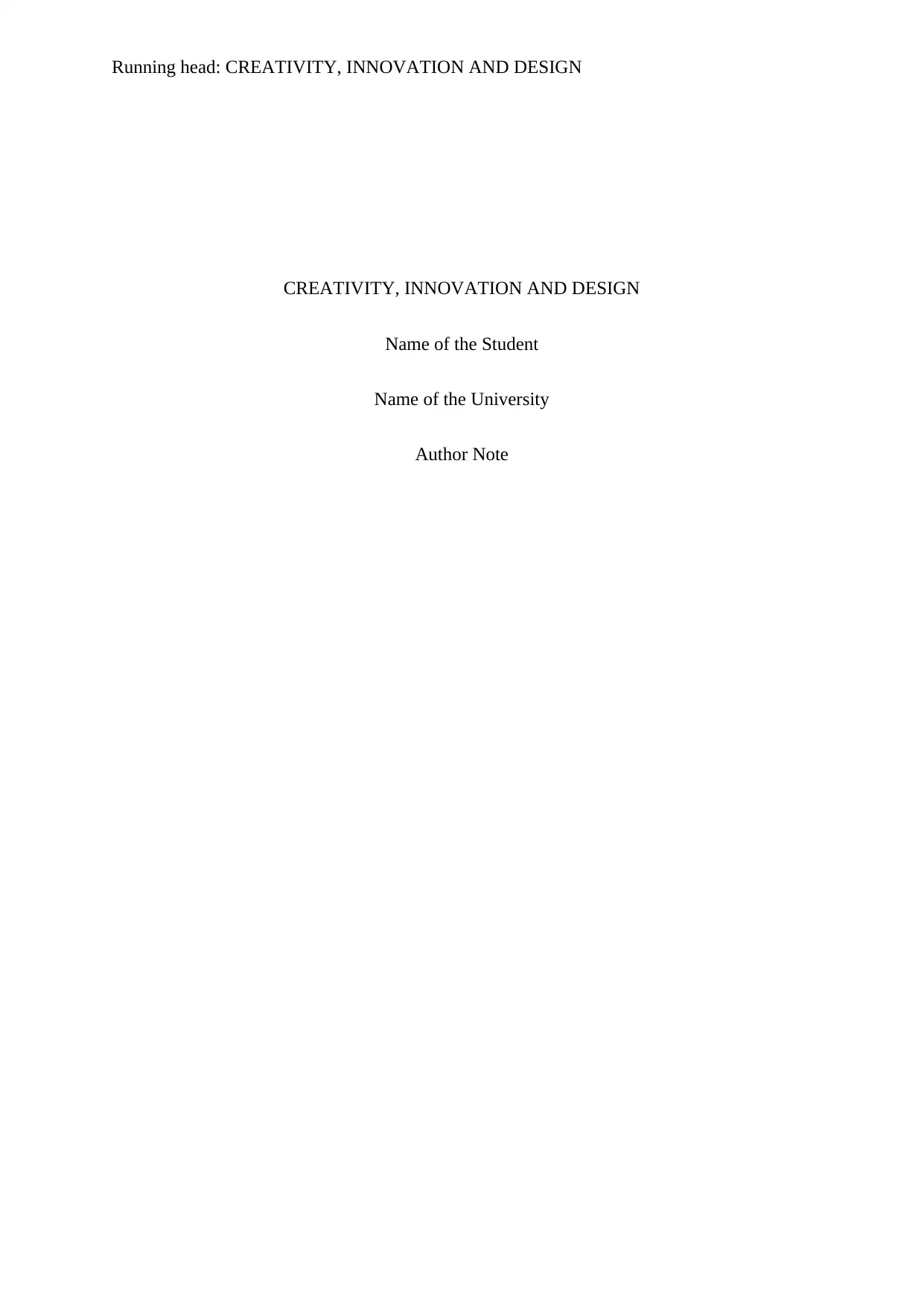
Running head: CREATIVITY, INNOVATION AND DESIGN
CREATIVITY, INNOVATION AND DESIGN
Name of the Student
Name of the University
Author Note
CREATIVITY, INNOVATION AND DESIGN
Name of the Student
Name of the University
Author Note
Paraphrase This Document
Need a fresh take? Get an instant paraphrase of this document with our AI Paraphraser
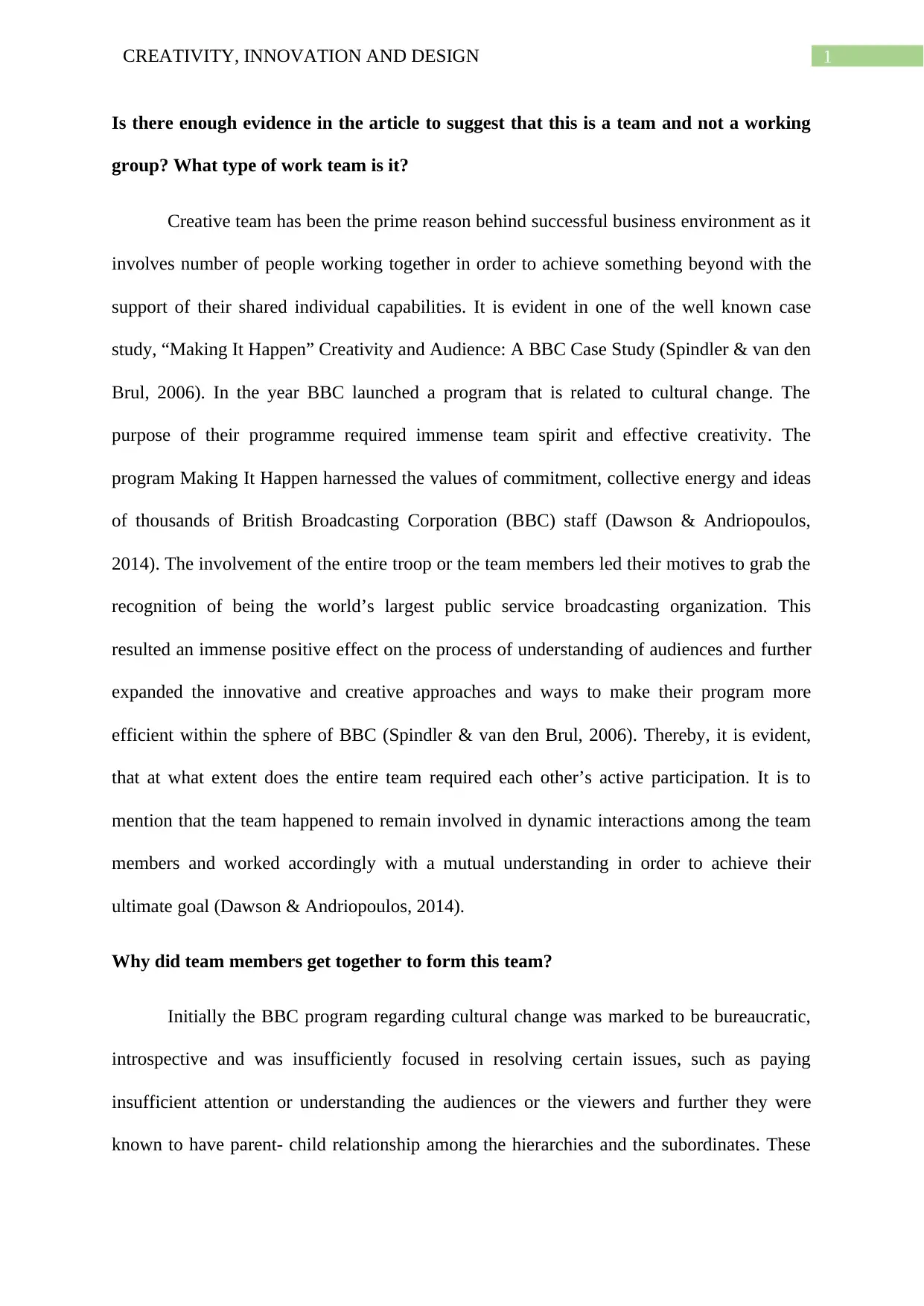
1CREATIVITY, INNOVATION AND DESIGN
Is there enough evidence in the article to suggest that this is a team and not a working
group? What type of work team is it?
Creative team has been the prime reason behind successful business environment as it
involves number of people working together in order to achieve something beyond with the
support of their shared individual capabilities. It is evident in one of the well known case
study, “Making It Happen” Creativity and Audience: A BBC Case Study (Spindler & van den
Brul, 2006). In the year BBC launched a program that is related to cultural change. The
purpose of their programme required immense team spirit and effective creativity. The
program Making It Happen harnessed the values of commitment, collective energy and ideas
of thousands of British Broadcasting Corporation (BBC) staff (Dawson & Andriopoulos,
2014). The involvement of the entire troop or the team members led their motives to grab the
recognition of being the world’s largest public service broadcasting organization. This
resulted an immense positive effect on the process of understanding of audiences and further
expanded the innovative and creative approaches and ways to make their program more
efficient within the sphere of BBC (Spindler & van den Brul, 2006). Thereby, it is evident,
that at what extent does the entire team required each other’s active participation. It is to
mention that the team happened to remain involved in dynamic interactions among the team
members and worked accordingly with a mutual understanding in order to achieve their
ultimate goal (Dawson & Andriopoulos, 2014).
Why did team members get together to form this team?
Initially the BBC program regarding cultural change was marked to be bureaucratic,
introspective and was insufficiently focused in resolving certain issues, such as paying
insufficient attention or understanding the audiences or the viewers and further they were
known to have parent- child relationship among the hierarchies and the subordinates. These
Is there enough evidence in the article to suggest that this is a team and not a working
group? What type of work team is it?
Creative team has been the prime reason behind successful business environment as it
involves number of people working together in order to achieve something beyond with the
support of their shared individual capabilities. It is evident in one of the well known case
study, “Making It Happen” Creativity and Audience: A BBC Case Study (Spindler & van den
Brul, 2006). In the year BBC launched a program that is related to cultural change. The
purpose of their programme required immense team spirit and effective creativity. The
program Making It Happen harnessed the values of commitment, collective energy and ideas
of thousands of British Broadcasting Corporation (BBC) staff (Dawson & Andriopoulos,
2014). The involvement of the entire troop or the team members led their motives to grab the
recognition of being the world’s largest public service broadcasting organization. This
resulted an immense positive effect on the process of understanding of audiences and further
expanded the innovative and creative approaches and ways to make their program more
efficient within the sphere of BBC (Spindler & van den Brul, 2006). Thereby, it is evident,
that at what extent does the entire team required each other’s active participation. It is to
mention that the team happened to remain involved in dynamic interactions among the team
members and worked accordingly with a mutual understanding in order to achieve their
ultimate goal (Dawson & Andriopoulos, 2014).
Why did team members get together to form this team?
Initially the BBC program regarding cultural change was marked to be bureaucratic,
introspective and was insufficiently focused in resolving certain issues, such as paying
insufficient attention or understanding the audiences or the viewers and further they were
known to have parent- child relationship among the hierarchies and the subordinates. These
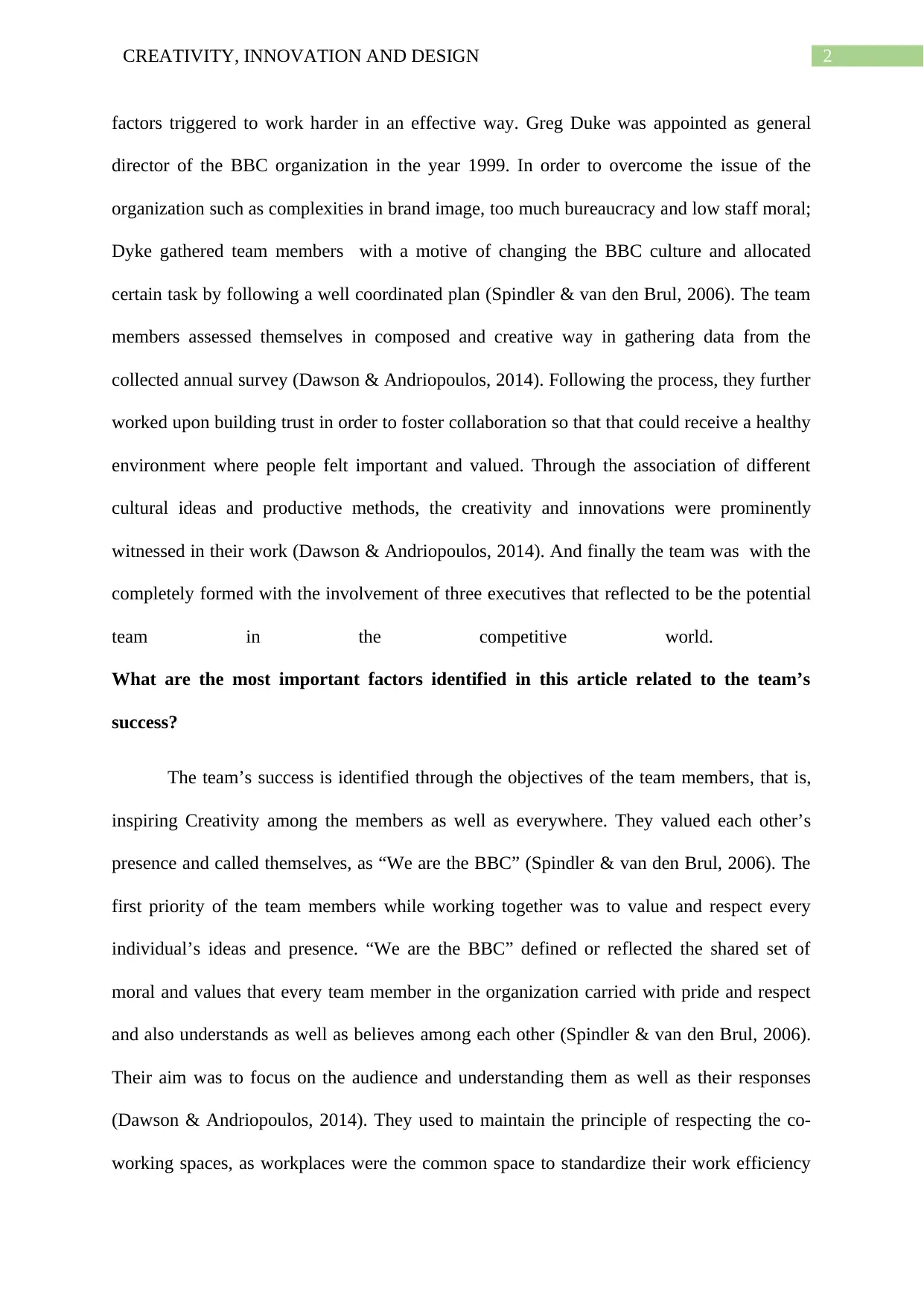
2CREATIVITY, INNOVATION AND DESIGN
factors triggered to work harder in an effective way. Greg Duke was appointed as general
director of the BBC organization in the year 1999. In order to overcome the issue of the
organization such as complexities in brand image, too much bureaucracy and low staff moral;
Dyke gathered team members with a motive of changing the BBC culture and allocated
certain task by following a well coordinated plan (Spindler & van den Brul, 2006). The team
members assessed themselves in composed and creative way in gathering data from the
collected annual survey (Dawson & Andriopoulos, 2014). Following the process, they further
worked upon building trust in order to foster collaboration so that that could receive a healthy
environment where people felt important and valued. Through the association of different
cultural ideas and productive methods, the creativity and innovations were prominently
witnessed in their work (Dawson & Andriopoulos, 2014). And finally the team was with the
completely formed with the involvement of three executives that reflected to be the potential
team in the competitive world.
What are the most important factors identified in this article related to the team’s
success?
The team’s success is identified through the objectives of the team members, that is,
inspiring Creativity among the members as well as everywhere. They valued each other’s
presence and called themselves, as “We are the BBC” (Spindler & van den Brul, 2006). The
first priority of the team members while working together was to value and respect every
individual’s ideas and presence. “We are the BBC” defined or reflected the shared set of
moral and values that every team member in the organization carried with pride and respect
and also understands as well as believes among each other (Spindler & van den Brul, 2006).
Their aim was to focus on the audience and understanding them as well as their responses
(Dawson & Andriopoulos, 2014). They used to maintain the principle of respecting the co-
working spaces, as workplaces were the common space to standardize their work efficiency
factors triggered to work harder in an effective way. Greg Duke was appointed as general
director of the BBC organization in the year 1999. In order to overcome the issue of the
organization such as complexities in brand image, too much bureaucracy and low staff moral;
Dyke gathered team members with a motive of changing the BBC culture and allocated
certain task by following a well coordinated plan (Spindler & van den Brul, 2006). The team
members assessed themselves in composed and creative way in gathering data from the
collected annual survey (Dawson & Andriopoulos, 2014). Following the process, they further
worked upon building trust in order to foster collaboration so that that could receive a healthy
environment where people felt important and valued. Through the association of different
cultural ideas and productive methods, the creativity and innovations were prominently
witnessed in their work (Dawson & Andriopoulos, 2014). And finally the team was with the
completely formed with the involvement of three executives that reflected to be the potential
team in the competitive world.
What are the most important factors identified in this article related to the team’s
success?
The team’s success is identified through the objectives of the team members, that is,
inspiring Creativity among the members as well as everywhere. They valued each other’s
presence and called themselves, as “We are the BBC” (Spindler & van den Brul, 2006). The
first priority of the team members while working together was to value and respect every
individual’s ideas and presence. “We are the BBC” defined or reflected the shared set of
moral and values that every team member in the organization carried with pride and respect
and also understands as well as believes among each other (Spindler & van den Brul, 2006).
Their aim was to focus on the audience and understanding them as well as their responses
(Dawson & Andriopoulos, 2014). They used to maintain the principle of respecting the co-
working spaces, as workplaces were the common space to standardize their work efficiency
⊘ This is a preview!⊘
Do you want full access?
Subscribe today to unlock all pages.

Trusted by 1+ million students worldwide
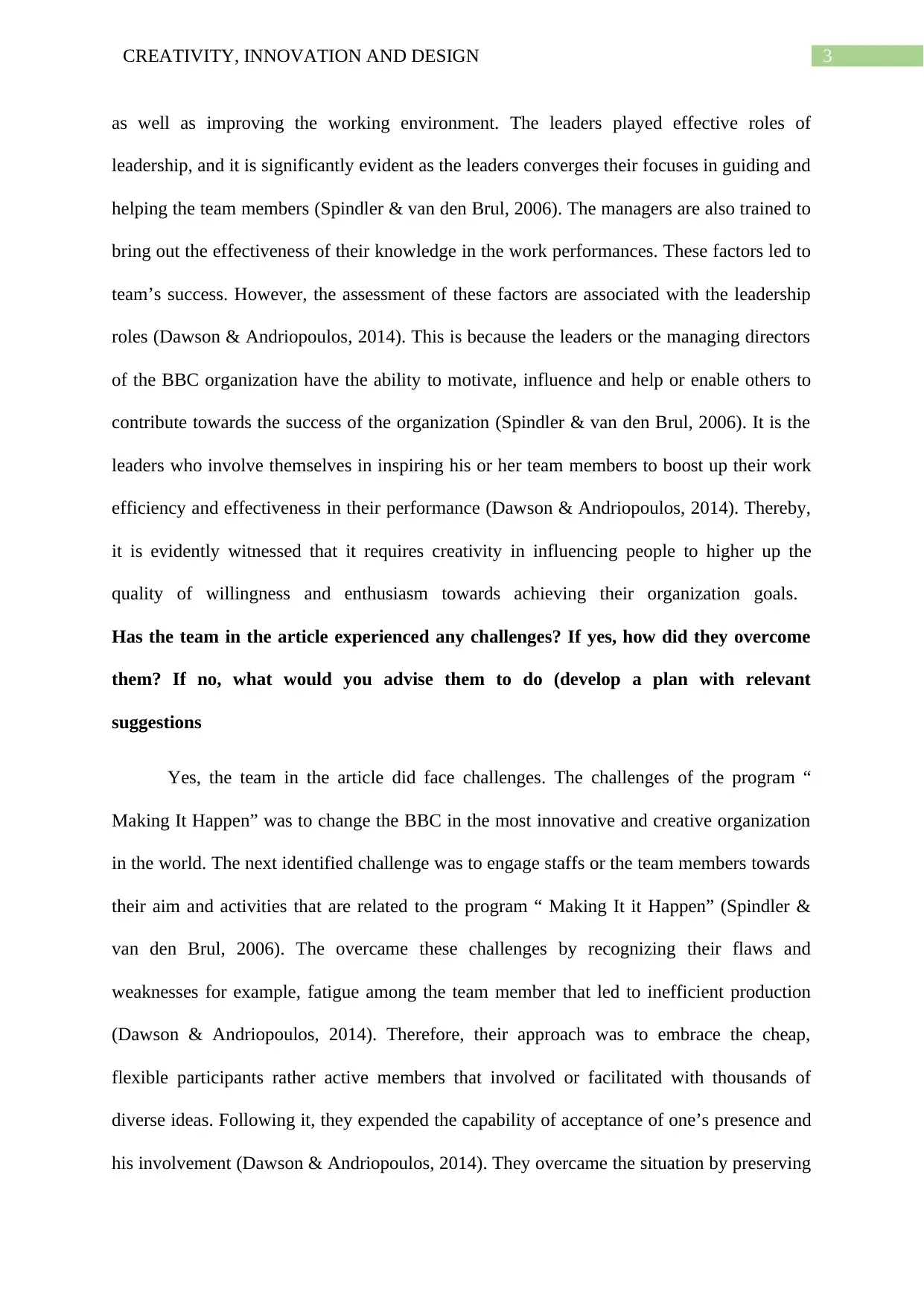
3CREATIVITY, INNOVATION AND DESIGN
as well as improving the working environment. The leaders played effective roles of
leadership, and it is significantly evident as the leaders converges their focuses in guiding and
helping the team members (Spindler & van den Brul, 2006). The managers are also trained to
bring out the effectiveness of their knowledge in the work performances. These factors led to
team’s success. However, the assessment of these factors are associated with the leadership
roles (Dawson & Andriopoulos, 2014). This is because the leaders or the managing directors
of the BBC organization have the ability to motivate, influence and help or enable others to
contribute towards the success of the organization (Spindler & van den Brul, 2006). It is the
leaders who involve themselves in inspiring his or her team members to boost up their work
efficiency and effectiveness in their performance (Dawson & Andriopoulos, 2014). Thereby,
it is evidently witnessed that it requires creativity in influencing people to higher up the
quality of willingness and enthusiasm towards achieving their organization goals.
Has the team in the article experienced any challenges? If yes, how did they overcome
them? If no, what would you advise them to do (develop a plan with relevant
suggestions
Yes, the team in the article did face challenges. The challenges of the program “
Making It Happen” was to change the BBC in the most innovative and creative organization
in the world. The next identified challenge was to engage staffs or the team members towards
their aim and activities that are related to the program “ Making It it Happen” (Spindler &
van den Brul, 2006). The overcame these challenges by recognizing their flaws and
weaknesses for example, fatigue among the team member that led to inefficient production
(Dawson & Andriopoulos, 2014). Therefore, their approach was to embrace the cheap,
flexible participants rather active members that involved or facilitated with thousands of
diverse ideas. Following it, they expended the capability of acceptance of one’s presence and
his involvement (Dawson & Andriopoulos, 2014). They overcame the situation by preserving
as well as improving the working environment. The leaders played effective roles of
leadership, and it is significantly evident as the leaders converges their focuses in guiding and
helping the team members (Spindler & van den Brul, 2006). The managers are also trained to
bring out the effectiveness of their knowledge in the work performances. These factors led to
team’s success. However, the assessment of these factors are associated with the leadership
roles (Dawson & Andriopoulos, 2014). This is because the leaders or the managing directors
of the BBC organization have the ability to motivate, influence and help or enable others to
contribute towards the success of the organization (Spindler & van den Brul, 2006). It is the
leaders who involve themselves in inspiring his or her team members to boost up their work
efficiency and effectiveness in their performance (Dawson & Andriopoulos, 2014). Thereby,
it is evidently witnessed that it requires creativity in influencing people to higher up the
quality of willingness and enthusiasm towards achieving their organization goals.
Has the team in the article experienced any challenges? If yes, how did they overcome
them? If no, what would you advise them to do (develop a plan with relevant
suggestions
Yes, the team in the article did face challenges. The challenges of the program “
Making It Happen” was to change the BBC in the most innovative and creative organization
in the world. The next identified challenge was to engage staffs or the team members towards
their aim and activities that are related to the program “ Making It it Happen” (Spindler &
van den Brul, 2006). The overcame these challenges by recognizing their flaws and
weaknesses for example, fatigue among the team member that led to inefficient production
(Dawson & Andriopoulos, 2014). Therefore, their approach was to embrace the cheap,
flexible participants rather active members that involved or facilitated with thousands of
diverse ideas. Following it, they expended the capability of acceptance of one’s presence and
his involvement (Dawson & Andriopoulos, 2014). They overcame the situation by preserving
Paraphrase This Document
Need a fresh take? Get an instant paraphrase of this document with our AI Paraphraser
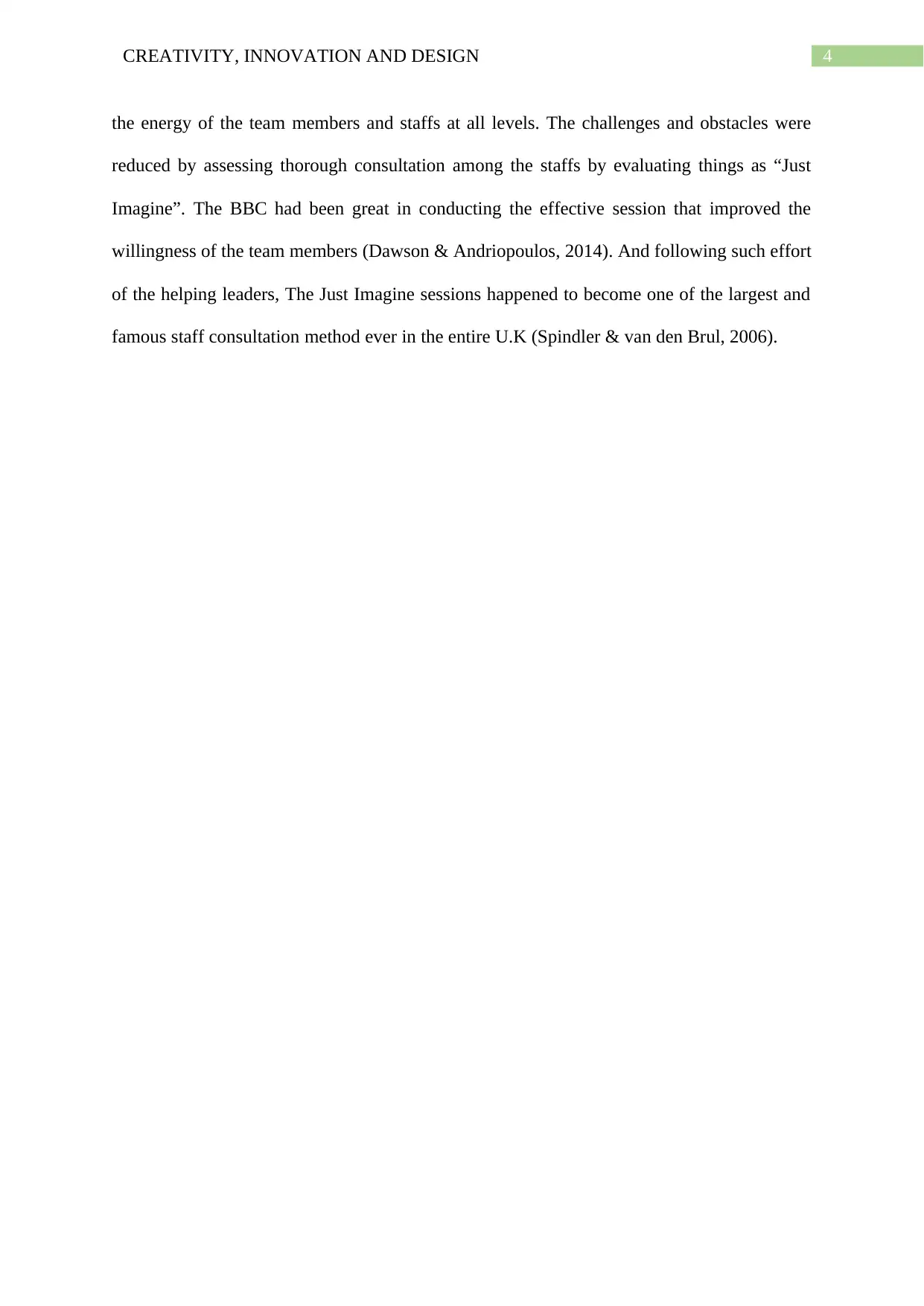
4CREATIVITY, INNOVATION AND DESIGN
the energy of the team members and staffs at all levels. The challenges and obstacles were
reduced by assessing thorough consultation among the staffs by evaluating things as “Just
Imagine”. The BBC had been great in conducting the effective session that improved the
willingness of the team members (Dawson & Andriopoulos, 2014). And following such effort
of the helping leaders, The Just Imagine sessions happened to become one of the largest and
famous staff consultation method ever in the entire U.K (Spindler & van den Brul, 2006).
the energy of the team members and staffs at all levels. The challenges and obstacles were
reduced by assessing thorough consultation among the staffs by evaluating things as “Just
Imagine”. The BBC had been great in conducting the effective session that improved the
willingness of the team members (Dawson & Andriopoulos, 2014). And following such effort
of the helping leaders, The Just Imagine sessions happened to become one of the largest and
famous staff consultation method ever in the entire U.K (Spindler & van den Brul, 2006).
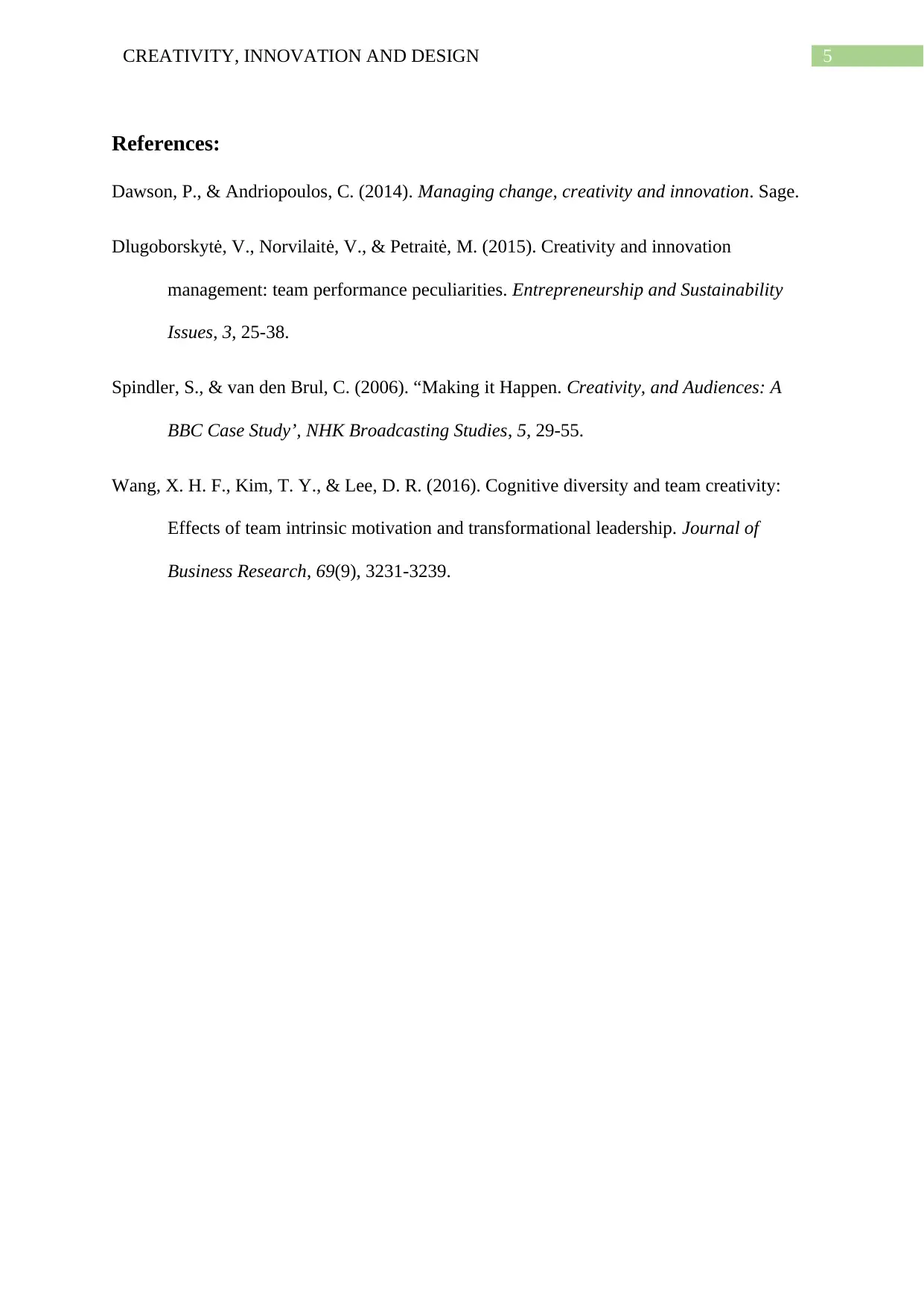
5CREATIVITY, INNOVATION AND DESIGN
References:
Dawson, P., & Andriopoulos, C. (2014). Managing change, creativity and innovation. Sage.
Dlugoborskytė, V., Norvilaitė, V., & Petraitė, M. (2015). Creativity and innovation
management: team performance peculiarities. Entrepreneurship and Sustainability
Issues, 3, 25-38.
Spindler, S., & van den Brul, C. (2006). “Making it Happen. Creativity, and Audiences: A
BBC Case Study’, NHK Broadcasting Studies, 5, 29-55.
Wang, X. H. F., Kim, T. Y., & Lee, D. R. (2016). Cognitive diversity and team creativity:
Effects of team intrinsic motivation and transformational leadership. Journal of
Business Research, 69(9), 3231-3239.
References:
Dawson, P., & Andriopoulos, C. (2014). Managing change, creativity and innovation. Sage.
Dlugoborskytė, V., Norvilaitė, V., & Petraitė, M. (2015). Creativity and innovation
management: team performance peculiarities. Entrepreneurship and Sustainability
Issues, 3, 25-38.
Spindler, S., & van den Brul, C. (2006). “Making it Happen. Creativity, and Audiences: A
BBC Case Study’, NHK Broadcasting Studies, 5, 29-55.
Wang, X. H. F., Kim, T. Y., & Lee, D. R. (2016). Cognitive diversity and team creativity:
Effects of team intrinsic motivation and transformational leadership. Journal of
Business Research, 69(9), 3231-3239.
⊘ This is a preview!⊘
Do you want full access?
Subscribe today to unlock all pages.

Trusted by 1+ million students worldwide
1 out of 6
Your All-in-One AI-Powered Toolkit for Academic Success.
+13062052269
info@desklib.com
Available 24*7 on WhatsApp / Email
![[object Object]](/_next/static/media/star-bottom.7253800d.svg)
Unlock your academic potential
Copyright © 2020–2025 A2Z Services. All Rights Reserved. Developed and managed by ZUCOL.